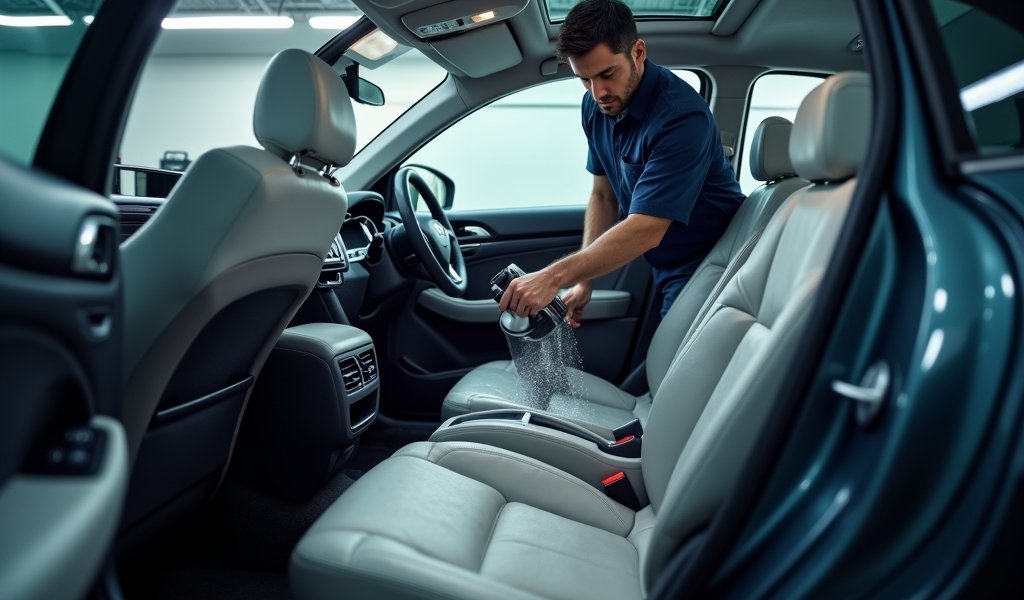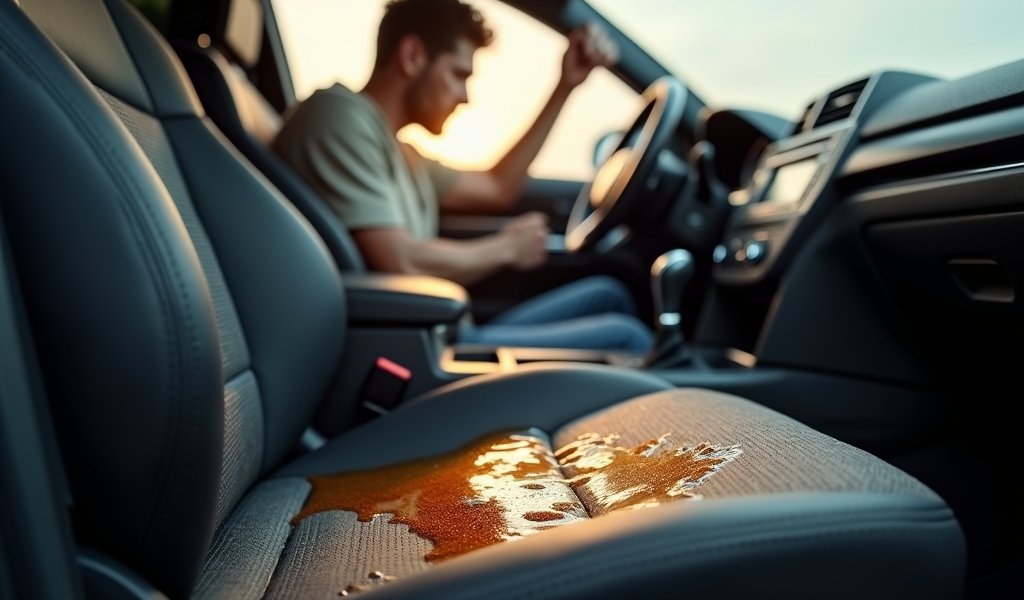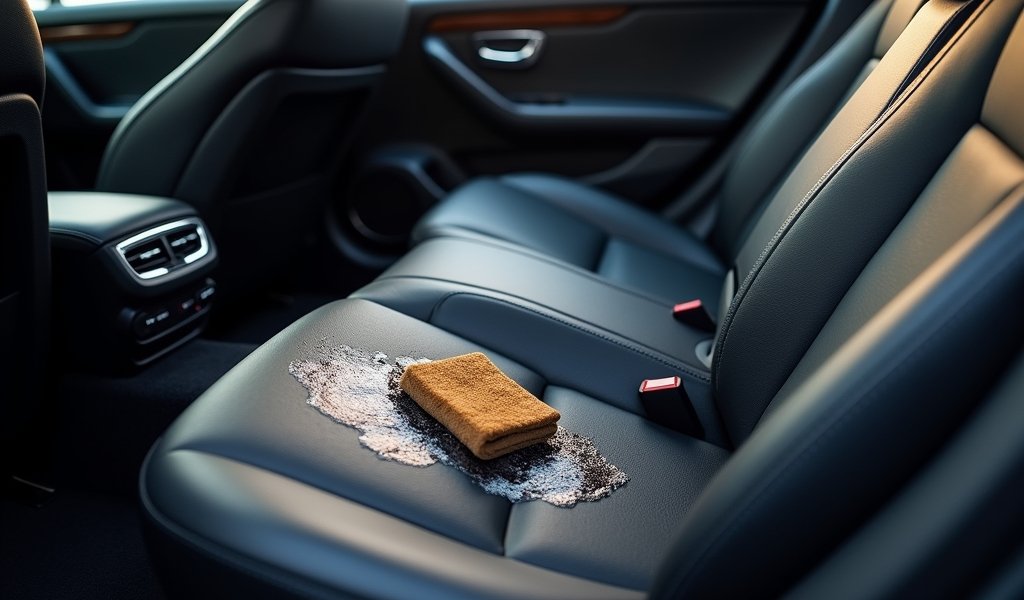Overview
This detailed guide on car upholstery cleaning provides professional advice on handling different types of spills across various upholstery materials, recommending specific commercial products like Chemical Guys Lightning Fast and DIY solutions for immediate and set-in stains. It emphasizes quick action, proper cleaning techniques, and preventative measures as the key strategies for maintaining your car’s interior in pristine condition.
Table of Contents
- Understanding Car Upholstery Types
- Common Types of Spills and Their Challenges
- Top Car Upholstery Cleaners for Different Situations
- DIY Cleaning Solutions That Actually Work
- Step-by-Step Cleaning Process
- Prevention: The Best Cleaning Strategy
- Conclusion
- Frequently Asked Questions
We’ve all experienced that moment of panic – watching in slow motion as coffee, soda, or some mystery substance from the back seat splashes onto your car’s upholstery. As a professional mechanic who’s seen thousands of vehicles in various states of interior distress, I can tell you that spills happen to everyone, but permanent stains don’t have to.
Quick action makes all the difference between a simple cleanup and a lasting reminder of that drive-thru mishap. In this guide, I’ll share professional insights on the best car upholstery cleaner for spills, whether you’re dealing with fresh accidents or stubborn stains that have been baking in the sun for weeks.
Understanding Car Upholstery Types
Before reaching for any cleaner, you need to know what material you’re working with. Different upholstery types require different cleaning approaches:
- Cloth Upholstery: Most common in economy and mid-range vehicles. It’s absorbent (which is both good and bad for cleaning) and typically more forgiving with cleaning products.
- Leather: Found in luxury vehicles, leather is less absorbent than cloth but can be permanently damaged by harsh cleaners. It requires both cleaning and conditioning.
- Synthetic Materials: Materials like nylon, polyester, or vinyl resist staining better than natural fibers but need specific cleaning approaches.
- Alcantara/Microsuede: This premium material found in high-performance vehicles mimics suede and requires gentle cleaning methods.
Think of your upholstery type as a roadmap – it guides which cleaning route will get you to your destination without damaging the landscape along the way.
Common Types of Spills and Their Challenges

In my 15+ years working with vehicles, I’ve seen it all. Here’s a breakdown of common spills and what makes each one challenging:
Beverage Spills
Coffee and tea contain tannins that bond to fabric fibers, while sodas leave sticky residues that attract dirt. Even water isn’t harmless – it can create mineral deposits or encourage mold growth if not properly dried.
The right coffee spill cleaner needs to break down these tannins without spreading the stain further.
Food Stains
From greasy french fries to ketchup drips, food stains combine oils, proteins, and colorful compounds that set into fabrics if not addressed quickly. These multi-component stains often require multi-step cleaning approaches.
Mud and Dirt
These seem straightforward but can grind into fibers when dry, causing abrasion and permanent discoloration. Always remove solid particles before applying any liquid cleaner.
Oil and Grease
Whether from food or actual car fluids, these stubborn stains repel water-based cleaners. They require degreasers to break down effectively.
Pet Accidents
Perhaps the most challenging category, these biological spills need not just cleaning but sanitizing and odor elimination to truly resolve the issue. Enzymatic cleaners are your best friend here.
According to Car and Driver research, addressing spills within the first 15 minutes dramatically increases your chances of complete removal.
Top Car Upholstery Cleaners for Different Situations
After testing hundreds of products on various upholstery types and stains, here are my professional recommendations:
Best Overall Upholstery Cleaners
- Chemical Guys Lightning Fast Stain Extractor – Versatile across fabric types with professional-grade cleaning power that works on fresh and set-in stains alike.
- Meguiar’s Carpet & Upholstery Cleaner – Excellent balance of cleaning power and fabric safety, with a built-in brush cap for mechanical agitation.
Best Budget-Friendly Options
- Armor All Carpet & Upholstery Cleaner – Delivers impressive results without breaking the bank.
- Simple Green All-Purpose Cleaner – When properly diluted (1:10 for upholstery), works wonderfully at a fraction of the cost of specialty products.
Best for Specific Stains
- For Coffee and Dark Beverages: Folex Instant Carpet Spot Remover excels at tackling tannins and dark pigments.
- For Grease and Oil: Tuff Stuff Multi-Purpose Foam Cleaner cuts through oil-based stains that water-based cleaners can’t touch.
- For Pet Accidents: Nature’s Miracle Auto Odor & Stain Eliminator uses enzymes that break down biological matter at the molecular level.
Best Eco-Friendly/Natural Cleaners
- Puracy Natural Carpet & Upholstery Shampoo – Plant-based ingredients deliver powerful cleaning without harsh chemicals.
- Biokleen Bac-Out Stain & Odor Remover – Combines natural enzymes and lime extract to tackle tough stains while remaining environmentally responsible.
The best car seat stain remover will vary depending on your specific situation, but having one multipurpose cleaner and one specialty product for your most common spill type is a smart approach.
DIY Cleaning Solutions That Actually Work
Sometimes the best cleaner is hiding in your kitchen cabinet. Here are some effective homemade solutions I’ve used in a pinch:
All-Purpose Fabric Cleaner
- 1 cup warm water
- ¼ cup white vinegar
- 1 tablespoon dish soap
Mix in a spray bottle and use sparingly. This combination tackles many common spills effectively.
Baking Soda Paste
For odors and set-in stains, make a paste with baking soda and water. Apply to the stain, let dry completely (typically 3-4 hours), then vacuum thoroughly.
Club Soda
The carbonation in club soda helps lift fresh stains, particularly those that are water-soluble like coffee or soda. Simply blot with a clean cloth dampened with club soda.
Safety Note: Never mix ammonia and bleach or vinegar and hydrogen peroxide, as these combinations create toxic gases. Also avoid DIY mixtures containing alcohol on leather upholstery as it can cause drying and cracking.
DIY solutions work best as first aid before using commercial products on stubborn stains. Always test any cleaner—homemade or commercial—in an inconspicuous area first to ensure colorfastness.
Step-by-Step Cleaning Process

The right cleaner is only half the battle – proper technique is equally important. Here’s my professional cleaning process:
Immediate Actions When Spills Occur
- Blot (never rub!) excess liquid with paper towels or a clean cloth
- Apply an absorbent material like baking soda or salt to soak up remaining moisture
- Vacuum up the absorbent material after 10-15 minutes
General Cleaning Technique
- Remove loose debris and vacuum thoroughly
- Apply your chosen cleaner according to product instructions
- Work from the outside of the stain inward to prevent spreading
- For fabric upholstery, avoid oversaturating – less is often more
- For leather, follow immediately with an appropriate conditioner
Dealing with Set-In Stains
- Rehydrate dried stains with a small amount of water
- Apply cleaner and let it dwell for the recommended time (usually 3-5 minutes)
- Use a soft-bristled brush to gently agitate without damaging fibers
- For persistent stains, a steam cleaner can help release embedded dirt
Drying Techniques
- Use clean, dry microfiber towels to remove excess moisture
- Position fans to increase air circulation
- Leave windows cracked if weather permits
- Consider a portable dehumidifier for particularly wet situations
Research from the Cleaning Management Institute shows that proper drying is crucial – dampness left behind is an invitation for mold and mildew growth.
Prevention: The Best Cleaning Strategy
As a mechanic who’s seen countless preventable interior disasters, I can tell you that an ounce of prevention truly is worth a pound of cure.
Protective Sprays and Coatings
Products like Scotchgard Fabric & Upholstery Protector create an invisible barrier that repels liquids, giving you precious extra seconds to react before absorption occurs. Reapply every 6-12 months for continued protection.
Car Seat Covers
Quality, fitted seat covers provide a sacrificial layer that can be easily removed and machine-washed. Modern options are far more attractive and comfortable than the universal covers of yesteryear.
Consider protecting your car seats from food and drink with specially designed covers if you frequently eat on the go.
Daily Habits
Simple rules like “no red drinks” or “use travel mugs with secure lids” can dramatically reduce spill incidents. Keep cleaning wipes in your glove compartment for immediate response to minor spills.
Organizational Products
Car seat back organizers, cup holder stabilizers, and properly sized trash containers help contain potential messes before they happen. An organized car is typically a cleaner car.
Conclusion
After years of rescuing vehicle interiors from beverage disasters and food catastrophes, I’ve found that success comes down to three factors: the right cleaner, quick action, and proper technique. For overall versatility, Chemical Guys Lightning Fast stands out as my top recommendation for the best car upholstery cleaner for spills, while budget-conscious car owners can achieve excellent results with Armor All’s affordable option.
Remember that regular maintenance cleaning is far easier than battling set-in stains. A quick wipe-down after minor spills and a more thorough cleaning every few months will extend your upholstery’s life and preserve your car’s value. Your car is likely one of your biggest investments – treating its interior with care ensures comfort, hygiene, and resale value for years to come.
Frequently Asked Questions
How soon should I clean up a spill in my car?
Immediately – within minutes if possible. The longer a spill sits, the more it penetrates the fibers and becomes harder to remove completely.
Can I use household cleaners on my car upholstery?
Some household cleaners work well when properly diluted, but avoid bleach and ammonia-based products. Always test in an inconspicuous area first before applying to visible upholstery.
What’s the best way to clean coffee spills from fabric car seats?
Blot immediately with a dry cloth, then use a specialized coffee stain remover or a mixture of vinegar and dish soap. Work from the outside in to prevent spreading the stain.
Are steam cleaners safe for car upholstery?
Steam cleaners are safe for most fabric upholstery but avoid using them on leather or vinyl. Always check your car’s manual or with the manufacturer if you’re unsure.
How do I prevent my car seats from getting stained?
Apply fabric protector sprays, use quality seat covers, establish no-food rules, and keep cleaning supplies in your vehicle. Prevention is always easier than cleaning established stains.


Pingback: How to Remove Stains From Car Upholstery - knowsyourcar.com